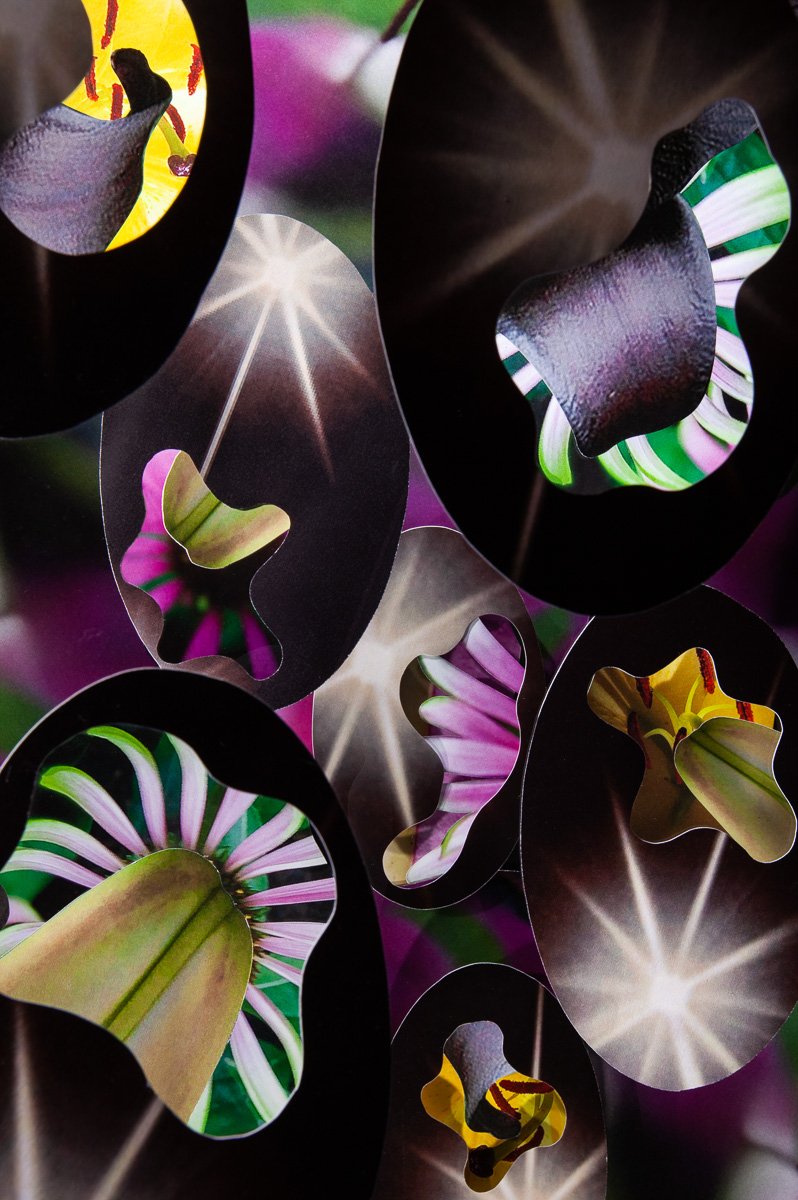John Woodruff, Arrangement # 12, 2022, Inkjet print, 40 x 30 inches, Unframed Print: $1500, Framed Print: $1800
I fell in love with photography through the Polaroid camera. Its immediate results were addictive.
Eventually my father gave me his 35mm Exakta. It had an inherent film transport issue and would frequently overlap at least part of two frames. What some viewed as a mistake was to me the find of a lifetime. To this day I continue to use, at least in part, the concept and power of overlapping images.
My photographs are about layers, illusion of depth, color, shape/form, restless energy and beauty in the simplest of things. To understand in more detail these aspects, upon graduation I took a position as a studio photographer and, a bit later, as the owner of an architectural photography studio. In both disciplines I gained extensive knowledge in lighting, composition, vantage points, depth of field and, most importantly, how to make that which I was photographing more provocative than it was.
For the last twenty years or so, I have used paper as the underlying element for creating my images. The paper is almost always cut into biomorphic shapes. My newest series is based on flowers I have shot over the last year. They are printed as xeroxes of varying sizes and then cut by hand from their respective backgrounds to segregate the flower itself. The flowers are then composed on elevated glass layers, which allow me to light each level independently.*
My inventive and poetic compositions embrace color and form and explore the illusion of depth resulting in visually charged, immersive photographs that challenge the viewers perception of what a photograph should be. They linger at the intersection of painting and photography, imagery and abstraction.
All of my photographs are created and produced in the studio. They are non-electronic photographic compositions.
– John Woodruff
About Process
Interview with Deb Dawson
DD: It’s interesting that you fell in love with photography through the instant results of a Polaroid camera. Then over time you delved deeper into more involved processes of photography. Can you share some of your early explorations of the various aspects of photography that led to your current work?
JW: Upon graduation, I accepted a position as a studio photographer. It was at this studio that I actually became a photographer, learning how to bring to life the images that resided in my mind’s eye. Many times I would stay late at the end of the day to cut and compose seamless paper. The paper had a natural curl and was available in an array of beautiful colors. With the skills I acquired, I was able to light the paper in such a way that it would enhance the color and dimensions of the curl. Everything I have ever done with my photographic art (with few exceptions) has involved paper as the subject, and the images have always been photographed in a studio setting. Shape form , color, restless energy, patterns and the illusion of depth became my focus and continues to drive my art to this day.
DD: Can you describe the process of creating the most recent series of floral compositions?
JW: All of my recent pieces are photographed using tiered sheets of glass and spotlights. The sheets of glass, separated by five inches for each sheet, can be lit independently from one another to highlight certain areas and cast shadows which in turn create the illusion of depth. Low, near horizon spotlights also give me texture and enhanced color. All of my images are non electronic, camera originals.
DD: A prior series made from 2019 - 2022 appears to be more abstract, yet the shapes are very organic. How has your education in biology influenced and informed your photography?
JW: While always being attracted to amorphous / organic shapes, formal training in biology helped me to achieve a deeper, more informed understanding.
DD: Do you view the world as a biologist or photographer? Or both? Do you find that the two are inseparably intertwined?
JW: I started reasonably young as a photographer (my father introduced the camer a to me early on), so I viewed what I saw in terms of the camera, but what biology did was to open up and confirm my embrace of the organic / cellular shape.
DD: As your restless mind works through these detailed photographic explorations, how do you see your work evolving?
JW: Evolve is a good word. As an artist, “evolve” means to work through it and that’s exactly what I do. I don’t take photographs, I make them. So, finding subjects that provoke my imagination typically means going into the studio and sketching new ideas from my thoughts.









